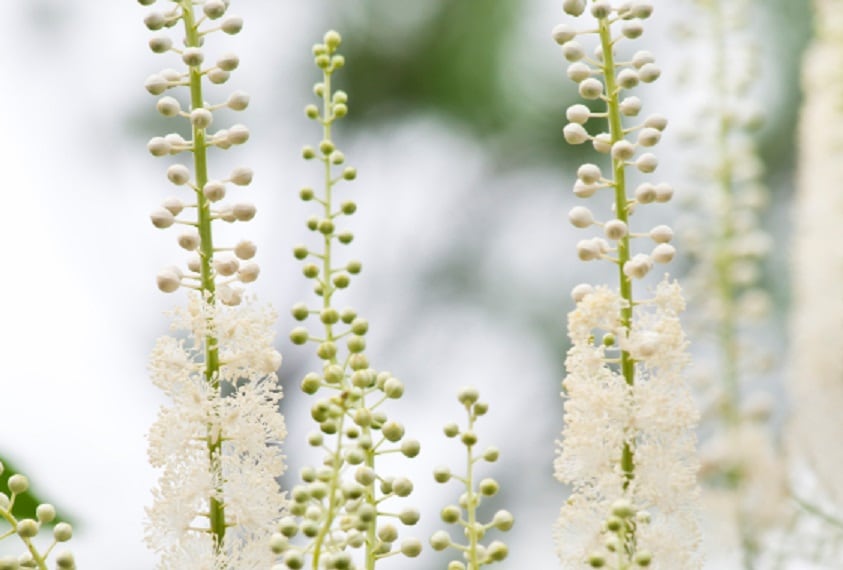The black cohosh (Actaea racemosa) document that covers the botanical’s root and rhizome forms has been issued by ABC’s Botanical Adulterants Program, which is a joint effort along with the American Herbal Pharmacopeia and the National Center for Natural Products Research. It joins a series of summaries and assessments of analytical methods for the authentication of botanical ingredients and the detection of potential adulterants the program has issued. Previously issued documents cover bilberry (Vaccinium myrtillis) fruit extract, which was issued in August of last year and skullcap (Scutellaria lateriflora) herb, issued in January.
Black cohosh, used to ameliorate the symptoms of menstruation and menopause, has been among the most durably popular botanical ingredients. This demand, as it has done for a number of other botanicals, has created a climate in which intentional adulteration, and to some extent unintentional adulteration, can occur. This is especially true with black cohosh, as closely related species which are difficult to distinguish from the real thing can be used to “cut” lots of material.
“Adulteration of black cohosh, mainly with herbal ingredients from Chinese Actaea species, remains a problem in the dietary supplement industry,” said Stefan Gafner, PhD, chief science officer of ABC and technical director of the Botanical Adulterants Program. “In the absence of easily recognizable morphological features, e.g., when cut or powdered roots and rhizomes, or root and rhizome extracts are purchased, authentication of black cohosh material is difficult.”
Pinning down proper black cohosh identification is a concern not only for fraud reasons. An article on the ingredient published in ABC’s journal Herbal Gram noted that the cases of liver toxicity attributed to black cohosh are exclusive related to cases of adulteration, and no toxicity concern exists with the pure ingredient.
Protracted gestation
Gafner said the document has been under development for more than two years. This unusually long gestation period spoke to the difficulty of the subject, and the complex nature of finding validated methods for distinguishing between closely related species. During the extensive peer review process, comments were received that in some cases contradicted each other, Gafner said.
“There were a lot of comments from the reviewers that didn’t always agree and we had to find a way to merge all of the comments in a way that all of the reviewers could support,” Gafner told NutraIngredients-USA.
The program’s LGDs are intended for quality control personnel and lab technicians in the herbal medicine, botanical ingredient, dietary supplement, and food sectors of industry to help them choose the most appropriate techniques and methods for their specific analytical needs. The LGDs provide reliable guidance on suitable methods to comply with the mandate to establish identity as part of the testing requirements (identity, purity, strength, and composition) outlined in the US Food and Drug Administration’s current Good Manufacturing Practices (cGMPs) for dietary supplements and/or conventional foods, as well as government-mandated cGMPs in other countries.
According to the black cohosh LGD, “Authentication of cut or powdered black cohosh rhizome is challenging due to the existence of closely related and sometimes co-habiting Actaea species with similar morphological features and chemical composition.… The need for sound analytical methods is further emphasized by the abundance of materials from China sold as ‘black cohosh’ but composed of root and sub-aerial material from entirely different species.”
Different chemotypes

Gafner said the situation is also complicated in the case of black cohosh in that the plant has been found to vary significantly in its chemical composition depending on growing conditions.
“There are pharmacopoeia identification methods that are considered to be validated, but some of these methods may not be 100 percent suitable for every case. It has been shown that the plant can have different chemotypes depending on where the plant is grown. You might end up rejecting some lots that are perfectly acceptable and pass some that are not. In these cases you might have to adopt and orthogonal approach,” he said.
The 8,000-word black cohosh guidance document reviews 36 analytical methods, including macroscopic and microscopic analyses, DNA-based tests, high-performance thin-layer chromatography (HPTLC), high-performance liquid chromatography (HPLC) and nuclear magnetic resonance (NMR), among others. The LGD includes three tables, five figures, and an appendix with expert comments on published HPLC methods for A. racemosa.
Document provided free
The program makes the guidance documents available free of charge to to industry members, researchers, health professionals, and the general public at no cost as part of the Botanical Adulterants Program’s policy of producing freely available educational documents on adulteration, made possible through funding by the Program’s underwriters and supporters. So far, more than 170 American and international parties have financially supported or otherwise endorsed the Program.
